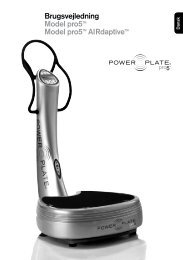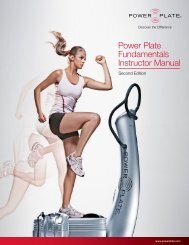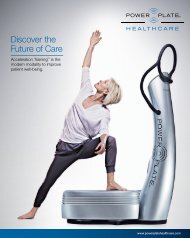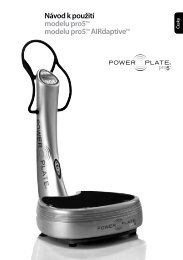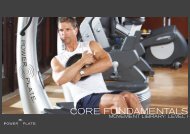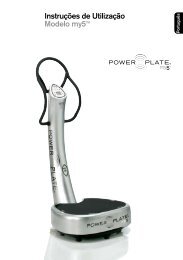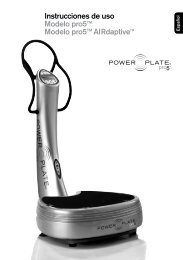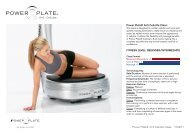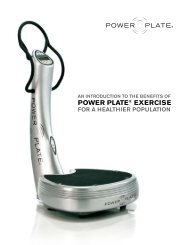Impact of Whole-Body Vibration Training Versus ... - Power Plate
Impact of Whole-Body Vibration Training Versus ... - Power Plate
Impact of Whole-Body Vibration Training Versus ... - Power Plate
Create successful ePaper yourself
Turn your PDF publications into a flip-book with our unique Google optimized e-Paper software.
Journal <strong>of</strong> Gerontology: MEDICAL SCIENCES<br />
2007, Vol. 62A, No. 6, 630–635<br />
Copyright 2007 by The Gerontological Society <strong>of</strong> America<br />
<strong>Impact</strong> <strong>of</strong> <strong>Whole</strong>-<strong>Body</strong> <strong>Vibration</strong> <strong>Training</strong> <strong>Versus</strong><br />
Fitness <strong>Training</strong> on Muscle Strength and Muscle Mass<br />
in Older Men: A 1-Year Randomized Controlled Trial<br />
An Bogaerts, 1 Christophe Delecluse, 2 Albrecht L. Claessens, 2 Walter Coudyzer, 3<br />
Steven Boonen, 4 and Sabine M. P. Verschueren 1<br />
1 Division <strong>of</strong> Musculoskeletal Rehabilitation, Department <strong>of</strong> Rehabilitation Sciences<br />
and 2 Research Center for Exercise and Health, Department <strong>of</strong> Biomedical Kinesiology,<br />
Faculty <strong>of</strong> Kinesiology and Rehabilitation Sciences, Katholieke Universiteit Leuven, Belgium.<br />
3 Radiology Section, Department <strong>of</strong> Morphology and Medical Imaging and<br />
4 Leuven University Center for Metabolic Bone Diseases and Division <strong>of</strong> Geriatric Medicine,<br />
Faculty <strong>of</strong> Medicine, Katholieke Universiteit Leuven, Belgium.<br />
Background. This randomized controlled study investigated the effects <strong>of</strong> 1-year whole-body vibration (WBV)<br />
training on isometric and explosive muscle strength and muscle mass in community-dwelling men older than 60 years.<br />
Methods. Muscle characteristics <strong>of</strong> the WBV group (n ¼ 31, 67.3 6 0.7 years) were compared with those <strong>of</strong> a fitness<br />
(FIT) group (n ¼ 30, 67.4 6 0.8 years) and a control (CON) group (n ¼ 36, 68.6 6 0.9 years). Isometric strength <strong>of</strong> the<br />
knee extensors was measured using an isokinetic dynamometer, explosive muscle strength was assessed using a counter<br />
movement jump, and muscle mass <strong>of</strong> the upper leg was determined by computed tomography.<br />
Results. Isometric muscle strength, explosive muscle strength, and muscle mass increased significantly in the WBV<br />
group (9.8%, 10.9%, and 3.4%, respectively) and in the FIT group (13.1%, 9.8%, and 3.8%, respectively) with the training<br />
effects not significantly different between the groups. No significant changes in any parameter were found in the CON group.<br />
Conclusion. WBV training is as efficient as a fitness program to increase isometric and explosive knee extension<br />
strength and muscle mass <strong>of</strong> the upper leg in community-dwelling older men. These findings suggest that WBV training<br />
has potential to prevent or reverse the age-related loss in skeletal muscle mass, referred to as sarcopenia.<br />
AGING is associated with a decline in muscle mass and<br />
muscle strength, referred to as sarcopenia (1). Sarcopenia<br />
is accompanied by decreased mobility, loss <strong>of</strong> independence,<br />
increased fall risk, and diminished quality <strong>of</strong> life<br />
(2–4). Additionally, sarcopenia may contribute to several<br />
age-related chronic disorders (e.g., osteoporosis, type 2 diabetes,<br />
insulin resistance, arthritis) and is considered to be<br />
a major public health concern in older individuals (2). Loss<br />
and atrophy <strong>of</strong> individual muscle fibers, decreased synthesis<br />
<strong>of</strong> muscle proteins, and reduced mitochondrial function<br />
constitute the primary physiological mechanisms that underlie<br />
sarcopenia (2,5–7). The prevalence <strong>of</strong> sarcopenia,<br />
estimated to be as high as 30% for persons older than 60 years<br />
(3), will increase further as the proportion <strong>of</strong> older persons<br />
continues to grow. In this regard, there is an urgent need for<br />
efficient and feasible interventions to prevent or reverse<br />
sarcopenia. Progressive resistance training appears to be<br />
effective to slow down the effects <strong>of</strong> aging on muscle (8,9).<br />
The increases in muscle strength and muscle mass are the<br />
results <strong>of</strong> high mechanical loading (with loads up to 70% and<br />
90% <strong>of</strong> one repetition maximum) (10,11). However, a significant<br />
proportion <strong>of</strong> elderly persons may be unable or<br />
unwilling to comply with high-intensity exercise regimens.<br />
<strong>Whole</strong>-body vibration (WBV) training might be an alternative<br />
to conventional resistance training. During WBV, the<br />
individual stands on a platform that generates vertical sinusoidal<br />
vibrations. These mechanical stimuli are transmitted to<br />
the body where they stimulate the primary endings <strong>of</strong> the<br />
muscle spindles, which in turn activate a-motor neurons<br />
resulting in muscle contractions, comparable to the tonic<br />
vibration reflex (12,13). Compared to conventional resistance<br />
training, long-term WBV training results in identical gains in<br />
muscle strength and jump performance in untrained young<br />
men and women as well as in postmenopausal women (14–<br />
16). In older men, the effects <strong>of</strong> WBV training have not yet<br />
been reported, nor have there been studies on the long-term<br />
effects <strong>of</strong> WBV on muscle mass. It has been hypothesized that<br />
the WBV-induced strength increase is mainly due to neural<br />
adaptations following the massive stimulation <strong>of</strong> propriospinal<br />
reflex pathways, whereas morphological changes (hypertrophy)<br />
would be rather limited (14,16). It has been shown<br />
that vibratory stimulation applied directly to the achilles<br />
tendon <strong>of</strong> rats attenuated an enlargement <strong>of</strong> slow- and fasttwitch<br />
fibers (17). In untrained young women, we previously<br />
reported a minor increase in total fat-free mass after 24 weeks<br />
<strong>of</strong> WBV training, measured by underwater weighing (18).<br />
The aim <strong>of</strong> the current randomized controlled trial was to<br />
measure the changes in muscle strength and muscle mass in<br />
men between 60 and 80 years after 1 year <strong>of</strong> WBV training.<br />
METHODS<br />
Participants were locally recruited, between 60 and 80<br />
years old, and noninstitutionalized. Exclusion criteria were<br />
630
VIBRATION EXERCISE AND SKELETAL MUSCLE MASS<br />
631<br />
Table 1. Characteristics <strong>of</strong> the <strong>Whole</strong>-<strong>Body</strong> <strong>Vibration</strong> <strong>Training</strong> Program<br />
Volume Duration<br />
Intensity<br />
Amplitude<br />
Number <strong>of</strong> Series per Exercise*<br />
Period (Week) <strong>of</strong> exercise (s) Frequency (Hz) (High 5 mm/Low 2.5 mm) Rest (s) Modality a b c d e f g h<br />
1 ! 4 30 35 Low 60 Static y 3 1<br />
5 ! 9 45 40 High 60 Dynamic þ Static § 3 1 1 1 1<br />
10 ! 14 60 40 High 45 Dynamic z 3 3 3 1 1 1<br />
15 ! 19 60 40 High 45 8 s principle k 3 3 3 1 1 1<br />
20 ! 24 60 30 High 30 8 s principle 3 3 3 1 1 1<br />
Midtests (25 ! 26) 30 30–35 Low 30 Dynamic þ Static 3 3 3 1 1 1<br />
25 ! 29 30–45 35 High 30 Dynamic 3 3 3 1 1 1<br />
30 ! 34 45–60 35 High 15 Dynamic 3 3 3 2 1 1 1<br />
35 ! 39 60 35 High 15 8 s principle 3 3 3 2 1 1 1 1<br />
40 ! 44 60 35 High 15 8 s þ Dynamic 3 3 3 2 1 1 1 1<br />
Posttests (45 ! 47) 60 35–40 High 15 8 s þ Dynamic 2 2 2 1 1 1 1 1<br />
Notes: *Exercises: (a) squat, (b) deep squat, (c) wide stance squat, (d) one-legged squat, (e) lunge, (f) toes-stand, (g) toes-stand deep, (h) moving heels.<br />
y Static: exercises are performed isometrically.<br />
z Dynamic: slowly going up (2 seconds), slowly going down (2 seconds).<br />
§ Dynamic þ static: the first two series were performed in a dynamic way, the last series in a static way.<br />
k 8 seconds principle: four repetitions performed in a dynamic way, 4 seconds static performance, four repetitions in a dynamic way, static performance until the end<br />
<strong>of</strong> the exercise.<br />
(i) diseases or medications known to affect bone metabolism<br />
or muscle strength and (ii) engagement in moderateintensity<br />
exercise programs for .2 hours/week. After a<br />
medical screening including a graded maximal bicycle test<br />
where heart rate was recorded continuously, 220 men (n ¼<br />
114) and women (n ¼ 106) were randomly assigned to one<br />
<strong>of</strong> three groups: the WBV group, fitness (FIT) group, or<br />
control (CON) group. All participants were enrolled in a<br />
1-year randomized controlled study on the effects <strong>of</strong> training<br />
on health-related parameters. Muscle mass was only measured<br />
in a subset <strong>of</strong> 97 men. The main focus <strong>of</strong> this article is<br />
muscle mass and muscle strength <strong>of</strong> those 97 participants<br />
(WBV: n ¼ 31, FIT: n ¼ 30, and CON: n ¼ 36). For comparison,<br />
isometric strength data <strong>of</strong> the 106 female participants<br />
(WBV: n ¼ 46, FIT: n ¼ 30, and CON: n ¼ 30) are<br />
described briefly at the end <strong>of</strong> the Results section.<br />
The study was approved by the University’s Human<br />
Ethics Committee according to the declaration <strong>of</strong> Helsinki.<br />
All participants gave written informed consent.<br />
Interventions<br />
The WBV and FIT groups trained three times weekly for<br />
1 year, with at least 1 day <strong>of</strong> rest between the training<br />
sessions. All sessions were held at the University <strong>Training</strong><br />
Center and were closely supervised by qualified health and<br />
fitness instructors.<br />
WBV Group<br />
The WBV group exercised for a maximum <strong>of</strong> 40 minutes<br />
on a vibration platform (<strong>Power</strong>plate, Amsterdam, The<br />
Netherlands): squat, deep squat, wide stance squat, toesstand,<br />
toes-stand deep, one-legged squat, and lunge. <strong>Training</strong><br />
load increased gradually according to the overload<br />
principle (Table 1).<br />
FIT Group<br />
The FIT group performed cardiovascular, resistance,<br />
balance, and flexibility exercises for about 1.5 hours in<br />
total. The guidelines <strong>of</strong> the American College <strong>of</strong> Sports<br />
Medicine for exercise prescription in older individuals were<br />
used to set up the intensity <strong>of</strong> the program (19). The cardiovascular<br />
program (70%–85% <strong>of</strong> the heart rate reserve)<br />
consisted <strong>of</strong> walking/running, cycling, or stepping. The<br />
resistance program (1–2 sets with a load between 8 and 15<br />
repetition maximum) consisted <strong>of</strong> exercises for the whole<br />
body, including leg press and leg extension (Technogym<br />
Systems, Gambetolla, Italy). Balance was trained by standing<br />
on one or both legs with the eyes open or closed, on<br />
a firm or unstable surface. At the end <strong>of</strong> each session, the<br />
participants performed stretching exercises.<br />
CON Group<br />
The CON group was repeatedly advised not to change<br />
lifestyle or physical activity during the project. The Flemish<br />
Physical Activity Computerized Questionnaire (FPACQ)<br />
determining lifestyle and activity patterns, showed no significant<br />
changes in physical activity level in the CON group<br />
during the study (p ¼ .909).<br />
Outcome Measurements<br />
Isometric and explosive strength <strong>of</strong> the quadriceps muscle<br />
and muscle mass <strong>of</strong> the upper leg were evaluated at baseline<br />
and after 12 months.<br />
Isometric strength.—Isometric knee extension strength<br />
was tested on an isokinetic dynamometer (Biodex; Shirley,<br />
NY) (20) on the right side, unless there was a medical<br />
problem. The rotational axis <strong>of</strong> the dynamometer was<br />
aligned with the transversal knee-joint axis and connected to<br />
the distal end <strong>of</strong> the tibia using a lever arm. The highest<br />
torque (Nm) <strong>of</strong> two maximal contractions (with a knee joint<br />
angle <strong>of</strong> 1208) was further analyzed.<br />
Explosive strength.—A counter movement jump (21) was<br />
performed on a contact mat to evaluate the explosive<br />
capacity <strong>of</strong> the lower limb muscles after a stretch-shortening<br />
cycle. We analyzed the average jump height (in centimeters)<br />
<strong>of</strong> three separate jumps.
632 BOGAERTS ET AL.<br />
Muscle mass.—A multislice computed tomography (CT)<br />
scan (Siemens Sensation 16; Forcheim, Germany) delivered<br />
axial slices <strong>of</strong> the right upper leg which were analyzed with<br />
the program Volume (Siemens). If necessary, corrections<br />
were made for artefacts (e.g., varix clips). The midpoint<br />
between the medial edge <strong>of</strong> the greater trochanter and the<br />
intercondyloid fossa <strong>of</strong> the patella was determined, and<br />
subsequently a 2 mm-thick axial image (1 mm above and<br />
1 mm below this midpoint) was further analyzed. This<br />
procedure was repeated 3 cm above and 3 cm below the<br />
midpoint. Muscle tissue area was segmented by using standard<br />
Hounsfield Units ranges for skeletal muscle (0–100)<br />
(22). We analyzed the summed muscle volume (in cubic<br />
centimeters) <strong>of</strong> the three slices. Corrections were made for<br />
bone marrow with similar Hounsfield Units as those <strong>of</strong><br />
skeletal muscle, as this tissue was also seen as muscle tissue.<br />
Test–retest reliability, evaluated by repeated scans within 2<br />
weeks in an extra group <strong>of</strong> 12 older men, yielded an intraclass<br />
correlation coefficient <strong>of</strong> 0.99. Measurements were<br />
performed in the Universitary Hospital and were executed<br />
by an expert radiologist.<br />
Statistical Analysis<br />
One-way analysis <strong>of</strong> variance (ANOVA) was used to test<br />
for differences between the groups at baseline. The changes<br />
over time in isometric strength, explosive strength, and<br />
muscle mass were analyzed by repeated-measures ANOVA.<br />
Contrast analysis was used to assess between- and withingroup<br />
differences. All analyses were executed using<br />
Statistica 6.1 (Stats<strong>of</strong>t, Tulsa, OK). Level <strong>of</strong> significance<br />
was set at p .05.<br />
RESULTS<br />
Dropouts and <strong>Training</strong> Compliance<br />
No adverse side effects <strong>of</strong> the intervention were reported<br />
in the training groups. All dropouts were related to personal<br />
reasons (n ¼ 5) or health problems (n ¼ 8), none <strong>of</strong> which,<br />
according to the physician, related to the training program.<br />
The average overall adherence (number <strong>of</strong> exercise classes<br />
attended as a percentage <strong>of</strong> the total number <strong>of</strong> classes) to<br />
the training program was 87.6% in the WBV group and<br />
87.1% in the FIT group. Only the results <strong>of</strong> the participants<br />
with a minimal compliance rate <strong>of</strong> 66% are reported. Therefore,<br />
two participants <strong>of</strong> the FIT group were not included in<br />
the analysis. Table 2 shows the basic characteristics <strong>of</strong> the<br />
remaining participants (WBV: n ¼ 25, FIT: n ¼ 25, CON:<br />
n ¼ 32). No significant baseline differences were detected<br />
between the groups in age, body mass, body mass index,<br />
maximal oxygen uptake (VO 2max ), isometric strength, explosive<br />
strength, and muscle mass. VO 2max was determined by<br />
gas analysis during a graded maximal bicycle test.<br />
Outcome Measurements<br />
Isometric strength.—Isometric strength <strong>of</strong> the men<br />
changed significantly over time (p ¼ .002), and this change<br />
was different for the three groups (p ¼ .009). Both the WBV<br />
and FIT groups showed significant improvements in muscle<br />
strength (9.8% [p ¼ .005] and 13.1% [p , .001],<br />
Table 2. Participant Characteristics <strong>of</strong> the Control (CON),<br />
Fitness (FIT), and <strong>Whole</strong>-<strong>Body</strong> <strong>Vibration</strong> (WBV) Groups<br />
(Mean 6 Standard Error)<br />
Characteristic<br />
CON<br />
(N ¼ 32)<br />
FIT<br />
(N ¼ 25)<br />
WBV<br />
(N ¼ 25)<br />
p<br />
Value*<br />
Age, y 68.6 6 1.0 67.6 6 0.9 66.9 6 0.7 .37<br />
<strong>Body</strong> mass, kg 80.6 6 1.5 84.2 6 2.1 79.9 6 2.0 .23<br />
<strong>Body</strong> mass index, kg/m 2 26.9 6 0.5 28.0 6 0.7 27.0 6 0.7 .44<br />
VO 2max , ml/min/kg 24.3 6 0.8 23.1 6 0.9 24.8 6 1.0 .43<br />
Isometric strength, Nm 165.2 6 7.3 164.3 6 7.4 161.3 6 6.8 .90<br />
Explosive strength, cm 16.2 6 0.9 16.9 6 1.1 16.5 6 0.7 .71<br />
Thigh muscle mass, cm 3 121.1 6 2.3 124.7 6 2.7 121.4 6 2.9 .57<br />
Notes: VO 2max ¼ Maximal oxygen uptake, determined by gas analysis<br />
during a graded maximal bicycle test.<br />
*Results <strong>of</strong> one-way analysis <strong>of</strong> variance.<br />
respectively), whereas no changes were detected in the<br />
CON group ( 0.6%, p ¼ .838) (Figure 1). The changes in<br />
both the WBV and FIT groups were different from those in<br />
the CON group (p ¼ .026 and p ¼ .004, respectively).<br />
<strong>Training</strong> effect was not significantly different between the<br />
training groups (p ¼ .467).<br />
Explosive strength.—Jump performance <strong>of</strong> the men<br />
changed significantly over time (p , .001), and this change<br />
was different for the three groups (p ¼ .031). Contrast<br />
analysis showed a significant improvement in explosive<br />
strength in the WBV group (10.9%, p , .001) and FIT group<br />
(9.8%, p , .001) but no significant changes in the CON<br />
group (1.8%, p ¼ .499) (Figure 2). <strong>Training</strong> effect was not<br />
significantly different between the training groups (p¼.808);<br />
both the WBV and FIT groups were significantly different<br />
from the CON group (p ¼ .017 and p ¼ .030, respectively).<br />
Muscle mass.—Muscle mass <strong>of</strong> the men changed significantly<br />
over time (p , .001), and this change was different<br />
for the three groups (p , .001), with a significant increase<br />
in the WBV (3.4%, p , .001) and FIT (3.8%, p , .001)<br />
groups but no changes in the CON group ( 0.7%, p ¼<br />
.180) (Figure 3). <strong>Training</strong> effect was similar in the WBV<br />
and FIT groups (p ¼ .465); both groups differed<br />
significantly from the CON group (p , .001 and p ,<br />
.001, respectively).<br />
Isometric strength <strong>of</strong> the women increased significantly<br />
over time (p , .001), and this change was different for the<br />
three groups (p ¼ .03). The WBV and FIT groups improved<br />
significantly (12.3%, p , .001 and 10.6%, p ¼ .005,<br />
respectively), whereas no changes were detected for the<br />
CON group (2.2%, p ¼ .468). <strong>Training</strong> effect was not significantly<br />
different between the training groups (p ¼ 714).<br />
Only the changes in the WBV group were significantly<br />
different from the changes in the CON group (p ¼ .01). The<br />
relative change over time in isometric strength was comparable<br />
for men and women <strong>of</strong> the WBV group (p ¼ .609),<br />
FIT group (p ¼ .194), and CON group (p ¼ .643).<br />
DISCUSSION<br />
To our knowledge, this is the first randomized controlled<br />
trial investigating the effects <strong>of</strong> 1-year WBV training on
VIBRATION EXERCISE AND SKELETAL MUSCLE MASS<br />
633<br />
Figure 1. Isometric knee extension strength in the control (CON), fitness (FIT), and whole-body vibration (WBV) groups at baseline (PRE) and at 1 year (POST).<br />
Results <strong>of</strong> repeated-measures analysis <strong>of</strong> variance are presented as means 6 standard errors. *Significant pre–post difference within group ( p , .05).<br />
muscle performance and muscle mass in communitydwelling<br />
men older than 60 years. In line with results<br />
previously reported in older women (15), our current findings<br />
confirm a WBV-induced increase in isometric and<br />
explosive muscle strength in men. Additionally, our study<br />
indicates that this improvement is not solely due to neurological<br />
adaptations, but also to an increase in muscle mass.<br />
Isometric muscle strength increased by about 10% in the<br />
WBV group participants. The relative improvement was<br />
comparable for men and women, indicating that both sexes<br />
Figure 2. Explosive muscle strength in the control (CON), fitness (FIT), and whole-body vibration (WBV) groups at baseline (PRE) and at 1 year (POST). Results <strong>of</strong><br />
repeated-measures analysis <strong>of</strong> variance are presented as means 6 standard errors. *Significant pre–post difference within group (p , .05).
634 BOGAERTS ET AL.<br />
Figure 3. Muscle mass in the control (CON), fitness (FIT), and whole-body vibration (WBV) groups at baseline (PRE) and at 1 year (POST). Results <strong>of</strong> repeatedmeasures<br />
analysis <strong>of</strong> variance are presented as means 6 standard errors. *Significant pre–post difference within group ( p , .05).<br />
respond similarly to vibration stimuli. The gains in isometric<br />
strength were similar to those induced by an equal number <strong>of</strong><br />
fitness training sessions. In a previous study in older women,<br />
we reported slightly higher increases in isometric strength<br />
after 6 months <strong>of</strong> WBV and FIT training (15% and 18.4%,<br />
respectively) (15). In the FIT group <strong>of</strong> the present study, the<br />
gain in muscle strength was also slightly lower than expected<br />
from other studies using high resistance and/or explosive<br />
strength training (23,24). However, training intensity <strong>of</strong> the<br />
present resistance training program was designed according<br />
to the recommendations <strong>of</strong> the American College <strong>of</strong> Sports<br />
Medicine to improve, not to maximize strength (19).<br />
It has been hypothesized that vibration training may<br />
improve muscle strength by facilitating neural control following<br />
tonic vibration reflex muscle activation (i.e., increase<br />
in motor unit synchronization, co-contraction <strong>of</strong> the synergist<br />
muscle, increased inhibition <strong>of</strong> the antagonist muscles,<br />
and increased ability <strong>of</strong> motor units to fire briefly at very<br />
high rates) (24–26). However, the extent to which WBV<br />
might induce muscle hypertrophy remained to be clarified<br />
(17,18). To our knowledge, this is the first study providing<br />
direct evidence for a WBV-induced increase in muscle mass.<br />
This increase was similar in magnitude (3%–4%) than the<br />
one observed in the FIT group. A coefficient <strong>of</strong> determination<br />
<strong>of</strong> 0.27 (r ¼ 0.52) between the gains in muscle<br />
strength and the gains in muscle mass suggests that, next to<br />
neural adaptations, also hypertrophic adaptations contribute<br />
to the functional improvements after long-term WBV.<br />
The gain in explosive strength in this study is in line with<br />
previous reports (14–16,27), and may indicate that WBV<br />
specifically trains fast-twitch fibers, although it remains<br />
unclear if there is a difference in hypertrophic response<br />
between slow- and fast-twitch fibers. Whereas highfrequency<br />
electrical stimulation has been shown to elicit<br />
a preferential recruitment <strong>of</strong> fast-twitch fibers (28–30),<br />
recent studies with electrostimulation resistance training and<br />
frequency-controlled muscle vibration suggest that slowtwitch<br />
fibers are also activated and develop hypertrophy<br />
(31,32). Because aging is associated with a preferential loss<br />
in size and number <strong>of</strong> fast-twitch fibers (33), future (biopsy)<br />
studies could examine the WBV-induced changes at the<br />
level <strong>of</strong> the individual muscle fibers.<br />
Our findings may have important clinical implications.<br />
WBV does not only improve muscle function but, because <strong>of</strong><br />
its hypertrophic effect, may potentially improve health<br />
outcome by reducing and/or reversing the age-related process<br />
<strong>of</strong> sarcopenia and its related disorders. Maintaining muscle<br />
strength and muscle mass may be critically important for<br />
elderly persons to perform daily activities and to remain<br />
independent (34). In this regard, the present results suggest<br />
that WBV training may potentially be useful as a low-impact<br />
training method to enhance muscle mass and muscle strength<br />
<strong>of</strong> the lower limb muscles in older individuals. In contrast<br />
with conventional resistance training, WBV training minimizes<br />
the need for conscious exertion and stress on the<br />
musculoskeletal, respiratory, and cardiovascular systems. In<br />
the context <strong>of</strong> this study, the compliance <strong>of</strong> the WBV<br />
program was excellent. The vibration sessions were experienced<br />
as pleasant and both socially and physically rewarding.<br />
After the study, most participants wanted to continue to<br />
participate, suggesting that WBV might be feasible over<br />
longer time periods, in apparently healthy older individuals.<br />
The hypertrophy due to WBV might also be beneficial for<br />
other populations with atrophy. For instance, it is well
VIBRATION EXERCISE AND SKELETAL MUSCLE MASS<br />
635<br />
known that long-term exposure to microgravity induces<br />
skeletal muscle atrophy in astronauts (35,36). In this respect,<br />
it has recently been shown that frequency-controlled muscle<br />
vibration during 55 days <strong>of</strong> bed rest results in a preservation<br />
<strong>of</strong> muscle strength and an increase in my<strong>of</strong>iber size (32).<br />
<strong>Vibration</strong> training may also have implications for patients in<br />
various clinical settings, including patients with neuromuscular<br />
diseases or those in rehabilitation.<br />
Conclusion<br />
The present study supports the use <strong>of</strong> WBV as an efficient<br />
training stimulus to enhance isometric and explosive muscle<br />
strength, and muscle mass, in community-dwelling men<br />
older than 60 years. WBV training deserves further research<br />
in instutionalized elderly persons in whom the control <strong>of</strong><br />
sarcopenia is even more critical for health and independence.<br />
ACKNOWLEDGMENTS<br />
This study was supported by grant G-0521-05 from the ‘Fonds voor<br />
Wetenschappelijk Onderzoek’ (FWO) to S. Boonen, S. Verschueren, C.<br />
Delecluse, and A. L. Claessens. S. Boonen is senior clinical investigator <strong>of</strong><br />
FWO and holder <strong>of</strong> the Roche & GSK Leuven University Chair in<br />
Osteoporosis. S. Verschueren is postdoctoral fellow <strong>of</strong> the ‘Bijzonder<br />
Onderzoeksfonds’ (BOF) (Katholieke Universiteit Leuven).<br />
We thank all the participants for their cooperation. We also thank Guus<br />
Van Der Meer, Jelte Tempelaars, and Nick De Poot for help in the design <strong>of</strong><br />
the WBV training program and for logistic support.<br />
CORRESPONDENCE<br />
Address correspondence to Christophe Delecluse, PhD, Faculty <strong>of</strong><br />
Kinesiology and Rehabilitation Sciences, Department <strong>of</strong> Biomedical<br />
Kinesiology, Katholieke Universiteit Leuven, Tervuursevest 101, 3001<br />
Leuven, Belgium. E-mail: christophe.delecluse@faber.kuleuven.be<br />
REFERENCES<br />
1. Rosenberg IH. Summary comments. Am J Clin Nutr. 1989;50:1231–<br />
1233.<br />
2. Deschenes MR. Effects <strong>of</strong> aging on muscle fibre type and size. Sports<br />
Med. 2004;34:809–824.<br />
3. Doherty TJ. Aging and sarcopenia. J Appl Physiol. 2003;95:1717–<br />
1727.<br />
4. Rouben<strong>of</strong>f R. Sarcopenia and its implications for the elderly. Eur J Clin<br />
Nutr. 2000;54(Suppl 3):S40–S47.<br />
5. Lexell J, Henriksson-Larsen K, Winblad B, et al. Distribution <strong>of</strong><br />
different fiber types in human skeletal muscles: effects <strong>of</strong> aging studied<br />
in whole muscle cross sections. Muscle Nerve. 1983;6:588–595.<br />
6. Lexell J, Taylor CC, Sjostrom M. What is the cause <strong>of</strong> the ageing<br />
atrophy? Total number, size and proportion <strong>of</strong> different fiber types<br />
studied in whole vastus lateralis muscle from 15- to 83-year-old men.<br />
J Neurol Sci. 1988;84:275–294.<br />
7. Balagopal P, Rooyackers OE, Adey DB, et al. Effects <strong>of</strong> aging on in<br />
vivo synthesis <strong>of</strong> skeletal muscle myosin heavy-chain and sarcoplasmic<br />
protein in humans. Am J Physiol. 1997;273:E790–E800.<br />
8. Frontera WR, Meredith CN, O’Reilly KP, et al. Strength conditioning<br />
in older men: skeletal muscle hypertrophy and improved function.<br />
J Appl Physiol. 1988;64:1038–1044.<br />
9. Taaffe DR, Pruitt L, Pyka G, et al. Comparative effects <strong>of</strong> high- and lowintensity<br />
resistance training on thigh muscle strength, fiber area, and<br />
tissue composition in elderly women. Clin Physiol. 1996;16:381–392.<br />
10. Fielding RA. The role <strong>of</strong> progressive resistance training and nutrition<br />
in the preservation <strong>of</strong> lean body mass in the elderly. J Am Coll Nutr.<br />
1995;14:587–594.<br />
11. Hagerman FC, Walsh SJ, Staron RS, et al. Effects <strong>of</strong> high-intensity<br />
resistance training on untrained older men. I. Strength, cardiovascular,<br />
and metabolic responses. J Gerontol Biol Sci. 2000;55A:B336–B346.<br />
12. Burke D, Schiller HH. Discharge pattern <strong>of</strong> single motor units in the<br />
tonic vibration reflex <strong>of</strong> human triceps surae. J Neurol Neurosurg<br />
Psychiatry. 1976;39:729–741.<br />
13. Hagbarth KE, Eklund G. Tonic vibration reflexes (TVR) in spasticity.<br />
Brain Res. 1966;2:201–203.<br />
14. Delecluse C, Roelants M, Verschueren S. Strength increase after wholebody<br />
vibration compared with resistance training. Med Sci Sports<br />
Exerc. 2003;35:1033–1041.<br />
15. Roelants M, Delecluse C, Verschueren SM. <strong>Whole</strong>-body-vibration<br />
training increases knee-extension strength and speed <strong>of</strong> movement in<br />
older women. J Am Geriatr Soc. 2004;52:901–908.<br />
16. Torvinen S, Kannus P, Sievanen H, et al. Effect <strong>of</strong> four-month vertical<br />
whole body vibration on performance and balance. Med Sci Sports<br />
Exerc. 2002;34:1523–1528.<br />
17. Falempin M, In-Albon SF. Influence <strong>of</strong> brief daily tendon vibration on<br />
rat soleus muscle in non-weight-bearing situation. J Appl Physiol.<br />
1999;87:3–9.<br />
18. Roelants M, Delecluse C, Goris M, et al. Effects <strong>of</strong> 24 weeks <strong>of</strong> whole<br />
body vibration training on body composition and muscle strength in<br />
untrained females. Int J Sports Med. 2004;25:1–5.<br />
19. American College <strong>of</strong> Sports Medicine. ACSM’s Guidelines for Exercise<br />
Testing and Prescription. 7th ed. Baltimore: Lippincott Williams &<br />
Wilkins; 2005:223–230.<br />
20. Drouin JM, Valovich-McLeod TC, Shultz SJ, et al. Reliability and<br />
validity <strong>of</strong> the Biodex system 3 pro isokinetic dynamometer velocity,<br />
torque and position measurements. Eur J Appl Physiol. 2004;91:22–29.<br />
21. Markovic G, Dizdar D, Jukic I, et al. Reliability and factorial validity <strong>of</strong><br />
squat and countermovement jump tests. J Strength Cond Res. 2004;<br />
18:551–555.<br />
22. Goodpaster BH, Kelley DE, Thaete FL, et al. Skeletal muscle attenuation<br />
determined by computed tomography is associated with skeletal<br />
muscle lipid content. J Appl Physiol. 2000;89:104–110.<br />
23. Ferri A, Scaglioni G, Pousson M, et al. Strength and power changes <strong>of</strong><br />
the human plantar flexors and knee extensors in response to resistance<br />
training in old age. Acta Physiol Scand. 2003;177:69–78.<br />
24. Hakkinen K, Kraemer WJ, Newton RU, et al. Changes in electromyographic<br />
activity, muscle fibre and force production characteristics<br />
during heavy resistance/power strength training in middle-aged and<br />
older men and women. Acta Physiol Scand. 2001;171:51–62.<br />
25. Enoka RM. Neural adaptations with chronic physical activity. J<br />
Biomech. 1997;30:447–455.<br />
26. Sale DG. Neural adaptation to resistance training. Med Sci Sports<br />
Exerc. 1988;20:S135–S145.<br />
27. Torvinen S, Kannus P, Sievanen H, et al. Effect <strong>of</strong> 8-month vertical<br />
whole body vibration on bone, muscle performance, and body balance:<br />
a randomized controlled study. J Bone Miner Res. 2003;18:876–884.<br />
28. Banerjee P, Caulfield B, Crowe L, et al. Prolonged electrical muscle<br />
stimulation exercise improves strength and aerobic capacity in healthy<br />
sedentary adults. J Appl Physiol. 2005;99:2307–2311.<br />
29. Cabric M, Appell HJ, Resic A. Fine structural changes in electrostimulated<br />
human skeletal muscle. Evidence for predominant effects on<br />
fast muscle fibres. Eur J Appl Physiol Occup Physiol. 1988;57:1–5.<br />
30. Neumayer C, Happak W, Kern H, et al. Hypertrophy and transformation<br />
<strong>of</strong> muscle fibers in paraplegic patients. Artif Organs.<br />
1997;21:188–190.<br />
31. Maffiuletti NA, Zory R, Miotti D, et al. Neuromuscular adaptations to<br />
electrostimulation resistance training. Am J Phys Med Rehabil. 2006;<br />
85:167–175.<br />
32. Blottner D, Salanova M, Puttmann B, et al. Human skeletal muscle<br />
structure and function preserved by vibration muscle exercise following<br />
55 days <strong>of</strong> bed rest. Eur J Appl Physiol. 2006;97:261–271.<br />
33. Lexell J. Human aging, muscle mass, and fiber type composition.<br />
J Gerontol A Biol Sci Med Sci.1995;50 Spec No:11–16.<br />
34. Hunter GR, McCarthy JP, Bamman MM. Effects <strong>of</strong> resistance training<br />
on older adults. Sports Med. 2004;34:329–348.<br />
35. Tesch PA, Berg HE, Bring D, et al. Effects <strong>of</strong> 17-day spaceflight on<br />
knee extensor muscle function and size. Eur J Appl Physiol.<br />
2005;93:463–468.<br />
36. LeBlanc A, Rowe R, Schneider V, et al. Regional muscle loss after short<br />
duration spaceflight. Aviat Space Environ Med. 1995;66:1151–1154.<br />
Received May 8, 2006<br />
Accepted September 19, 2006<br />
Decision Editor: Luigi Ferrucci, MD, PhD



